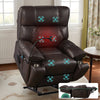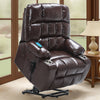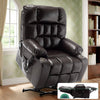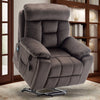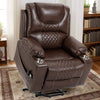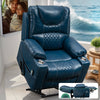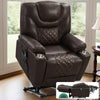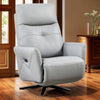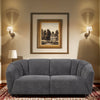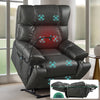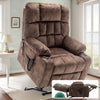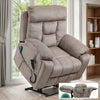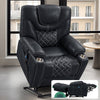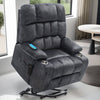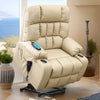Understanding the Basics of Elderly Chair Lifts
What is an Elderly Chair Lift?
An elderly chair lift, also known as a lift recliner chair, is a specialized piece of furniture. It's designed to help older adults or those with mobility issues. These chairs can lift and tilt forward, making it easier to stand up or sit down. They often have reclining features for comfort. Some models even offer massage or heating functions. Chair lifts come in various styles and sizes to suit different needs and spaces.

The Importance of Ergonomics in Seating for the Elderly
Ergonomics plays a crucial role in elderly seating. It's about creating a comfortable and safe environment. Good ergonomics can prevent pain and injury. It also promotes better posture and circulation. Ergonomic chairs support the spine and reduce pressure on joints. They often have adjustable features to fit different body types. Proper ergonomics can improve quality of life for seniors. It helps maintain independence and reduces the risk of falls.
Key Features to Look for in a Chair Lift for Elderly Use
When choosing a chair lift, several key features are important:
- Sturdy construction for safety and durability
- Easy-to-use controls, often with a remote
- Smooth lifting mechanism for gentle transitions
- Comfortable padding and upholstery
- Adjustable recline positions
- Battery backup in case of power outages
- Weight capacity suitable for the user
- Anti-slip fabric to prevent sliding
- Arm and headrests for added support
- Optional features like heat or massage
Look for chairs that meet safety standards and have good reviews from other users.
Assessing the Need for a Chair Lift in Your Home
When is a Chair Lift Necessary for Elderly Care?
A chair lift becomes necessary when an elderly person struggles with mobility. Signs include:

- Difficulty standing up from seated positions
- Increased risk of falls when getting in or out of chairs
- Muscle weakness or joint pain that affects movement
- Recovery from surgery or injury
- Conditions like arthritis or Parkinson's disease
- Fatigue from sitting in regular chairs for long periods
If you notice these issues, it might be time to consider a chair lift. Consult with a doctor or occupational therapist for advice.
Evaluating the Space and Layout for a Chair Lift Installation
Before getting a chair lift, assess your living space:
- Measure the area where the chair will be placed
- Ensure there's enough room for the chair to fully recline
- Check for nearby power outlets
- Consider the flow of traffic around the chair
- Look for a spot that allows easy access to other rooms
- Think about the chair's proximity to windows or TV for comfort
- Make sure doorways and hallways can accommodate the chair's size
Proper planning ensures the chair fits well and enhances the living space.
Identifying the Specific Needs of Your Elderly Loved One
Every senior has unique needs. Consider these factors:
- Physical conditions or limitations
- Height and weight for proper sizing
- Preferred sitting positions
- Need for additional features like heat or massage
- Ability to operate controls independently
- Frequency of use throughout the day
- Aesthetic preferences to match home decor
- Budget constraints for purchase and maintenance
Involving your loved one in the decision-making process is important. It ensures they're comfortable with the choice.
Selecting the Right Chair Lift for Elderly Users
Criteria for Choosing the Best Chair Lift
When selecting a chair lift, consider these criteria:

- Safety features like sturdy construction and stable base
- Ease of use, including simple controls and smooth operation
- Comfort level, with adequate padding and support
- Durability and quality of materials used
- Range of motion to suit the user's needs
- Size and fit for both the user and the room
- Power source options (electric vs. battery-operated)
- Warranty and customer support from the manufacturer
- Price and value for money
- Positive reviews and recommendations from other users
Take time to compare different models based on these factors.
Innovations and Trends in Elderly Chair Lifts
The field of elderly chair lifts is constantly evolving. Recent innovations include:
- Smart features like voice control and smartphone apps
- Improved battery life for cordless operation
- More customizable options for personalized comfort
- Sleeker designs that blend better with home decor
- Enhanced safety features like sensors and emergency buttons
- Eco-friendly materials and energy-efficient motors
- Multi-functional designs that serve as beds or wheelchairs
- Improved weight capacities for bariatric users
Stay informed about new technologies to find the best options available.
The Legal and Safety Considerations of Chair Lift Installation in the U.S.
In the U.S., chair lift installation involves legal and safety aspects:
- Compliance with the Americans with Disabilities Act (ADA)
- Meeting local building codes and regulations
- Proper electrical wiring and grounding
- Professional installation by certified technicians
- Regular safety inspections and maintenance
- Proper documentation for insurance purposes
- Understanding warranty terms and conditions
- Awareness of recall notices or safety alerts
Consult with local authorities or a professional installer for specific requirements in your area.
Tips for Maintaining and Operating Your Chair Lift for Elderly Users
Proper maintenance ensures longevity and safety:
- Read the user manual thoroughly
- Keep the chair clean and free from debris
- Regularly check for loose parts or wear
- Lubricate moving parts as recommended
- Test all functions periodically
- Keep the area around the chair clear
- Train all caregivers on proper operation
- Schedule professional servicing as needed
- Replace batteries in remote controls regularly
- Keep the power cord in good condition
Following these tips will help maintain the chair's performance and safety over time.








